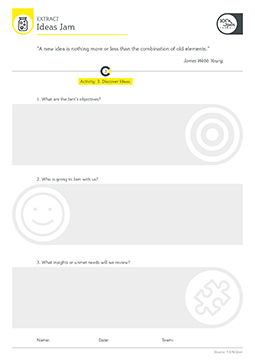Ideas Jam
“A new idea is nothing more or less than the combination of old elements.”James Webb Young


This is a collaborative style of workshop that deliberately mixes diverse people and disciplines to find new powerful hybrid ideas. A lot of time can be wasted on ineffective ideas sessions. This tool is a ‘how to’ for ensuring that we maximise productivity. Getting innovation partners involved in the generation and development of ideas in an Ideas Jam helps gain buy-in and maintains momentum at later stages of the innovation process.

A Jam workshop depends on three main ingredients:
We should set aside time to create a record of the day afterwards, using as much visual material as possible. We will design our Ideas Jam around this typical agenda.
0900: Welcome, sharing unmet needs (using Unmet Need cards) and agreeing objectives
0930: Collaborative warm up exercises from Co-creation Techniques.
1000: Plenary idea brainstorm using Co-creation Techniques
1100: Break (facilitators classify ideas so far. Delegates go on a ‘photo safari’ to collect interesting images for stimulus)
1130: Develop and role play using Personas in breakout groups
1200: Hold a second ideas brainstorm using sticky notes in breakout groups that are formed around the facilitators’ idea classification
1230: A well-earned lunch
1330: Groups present back their best ideas
1430: Everyone dot votes on the top 3 ideas per group
1500: Idea development using Idea Frame or Sketch Templates
1600: Groups present back their best ideas
1700: Conclude and agree next steps
1730: Close
The key output for this Jam is a short list of powerful and agreed ideas. We brainstorm and co-author ideas in breakout groups and then present the best ideas to the room. Next we gain consensus by voting for the most original and relevant ideas using sticky dots. Ideas can be captured in any number of ways. 100%Open always photographs all the materials for later analysis. This includes all the sticky notes and sketches. Often the idea presentations are captured on video. An efficient way of recording ideas is to use Idea Frame to provide a clear definition of an idea. People are also encouraged to be as visual as possible, sketching ideas, using photography or found art to illustrate ideas or by using Sketch Templates to bring ideas alive.
First we agree with our fellow jammers what we are going to achieve and why. For example what type of ideas do we need? How many and in what form? How are we going to develop them afterwards?
Productive Jams are all about the clash of cultures and the collision of perspectives. Clearly we need to invite any existing stakeholders in the project. We also include any collaboration partners or people from relevant innovation networks. It’s a good idea to invite (and pay for) some neutral domain experts, whether practitioners or academics.
It is crucial to bring good user insights to an Ideas Jam. When planning the workshop we will need to review any existing market research and prepare Unmet Need cards. Alternatively we could use social media (Social Listening) or crowdsourcing (Insight Crowd) to find fresh insights. We will also use these insights to create user personas (Personas tool) in the workshop.
Related tools checklist:
Bring Social Listening, Personas and Insight Crowd
Brainstorm with Collaborative Workshop Practices and Co-creation techniques
Build with the Unmet Need, Idea Frame and Sketch Templates
You must be logged in to download this tool
You must be logged in to download this worked example
2014 - 100%OPEN LTD